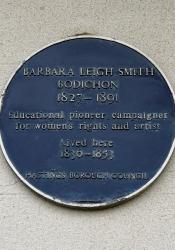Barbara Leigh Smith Bodichon
Barbara Leigh Smith Bodichon, born in 1827, grew up in Whatlington Britain. Barbara was raised by her father Benjamin Leigh Smith. Interestingly enough, Florence Nightingale was Benjamin’s niece, and he grew up with four sisters and one brother. Her father, Benjamin Leigh Smith, was considered a Dissenter. Similar to Margaret’s father in North and South, Barbara’s father held radical views and moved her family to Sussex England. Benjamin Leigh Smith was a supporter of Free Trade and was considered a Unitarian and he consistently donated to charity. For example, in 1826, he built a school for the poor of Vincent Square. Benjamin Smith had a wide abundance of illegitimate children, however, he still became a magistrate in England. Eventually, this event led to her retirement from parliament.
Barbara’s situation growing up provided her with the opportunity to live her life more freely than women typically were able to. This being said, Barbara was still denied an education at Cambridge. In her early years, Barbara was a painter and she used her high societal status to interact with the bohemian and the artistic. Due to her father’s high standing, Barbara was continually accepted in her community. Likewise, she was introduced to high-standing people such as William Hunt, Elizabeth Barrett Browning, and George Eliot. In 1854, Barbara wrote A Brief Summary, in Plain Language, of the Most Important Laws Concerning Women. In this paper, Barbara examines the legal restrictions placed on women in England. Barbara was particularly concerned with the women's ‘non-existence within marriage.’ Or in other words, the legal property given to the man of the relationship during the marriage (all legal belongings, children, etc.). Because of this, Barbara formed a committee to make a reform on women’s legal rights within marriage. The committee gained wide attraction and support, it even received 26,000 signatures in 1856. However, it was eventually rejected. This being said, parliament passed ‘The Married Women’s Property Bill’ in 1857.
Barbara’s work had a huge influence on the Late-Victorian Feminist movement. One of the influences of the movement “invented new communities of their own-communities that were defined not by marital status but by a mutual desire to transform late-victorian society” (Elford 32). Once again, this was one of the main focuses of Barbara’s feminist work. As we’ve discussed in class, Barbara’s actions were a response to the ‘women-question,’ or in other words, she was interested in a non-married women’s role in society. For Barbara, she wanted to advance the cause of women. We can see similar questions brought up in Jane Eyre and North and South. Likewise, Barbara, like both Jane and Margaret ran into a type of inheritance that led each of these women to question their role in society.
Works Cited
ELFORD, JANA SMITH. “The Late-Victorian Feminist Community.” Victorian Review, vol. 41, no. 1, Victorian Studies Association of Western Canada, 2015, pp. 32–35, http://www.jstor.org/stable/24877740.
Wojtczak, Helena. “Barbara Leigh Smith (Madame Bodichon) and Hastings.” Barbara Bodichon and Hastings, victorianweb.org/gender/wojtczak/bodichon.html.

